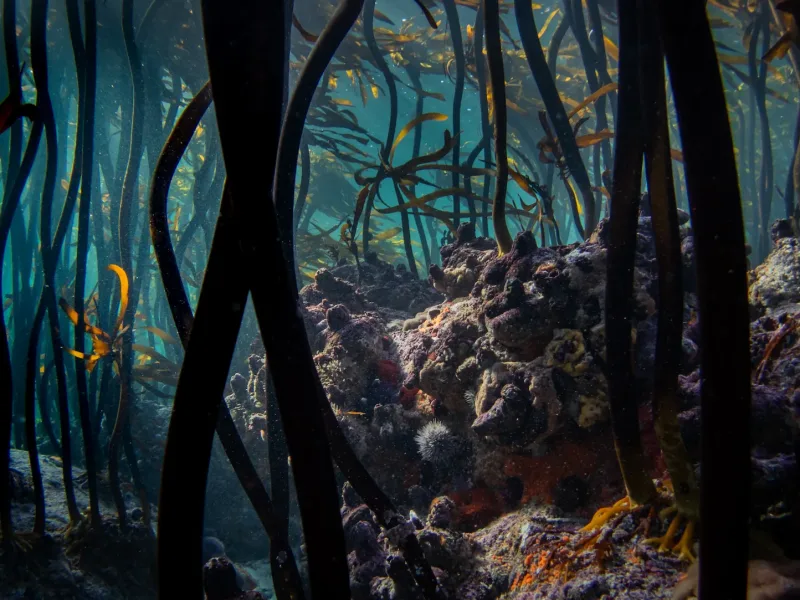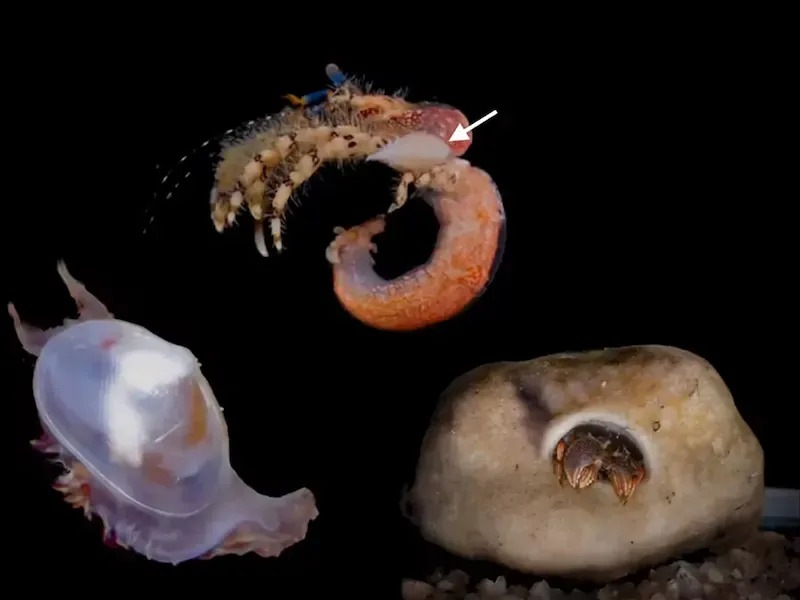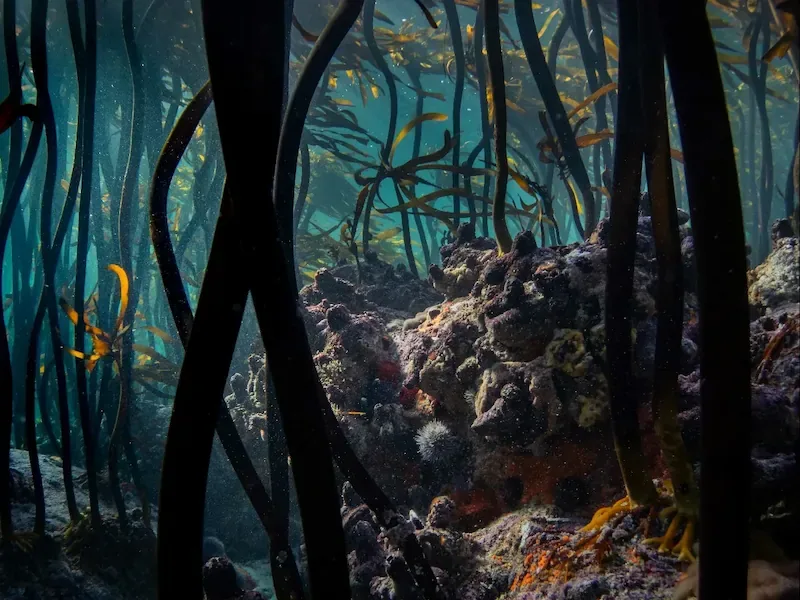1001 Seaforest Species
The 1001 Seaforest Species project brings ashore the stories of 1001 organisms that call the Great African Seaforest home. A scientific inquiry with the art of underwater tracking and storytelling at its heart, core members Dr Jannes Landschoff, Emeritus Professor Charles Griffiths and Craig Foster unveil the secret lives of these creatures. This bid to build a lasting seedbank of species knowledge is driven by an urgent call to inspire awareness of and awe for nature.
Biodiversity – that breathtaking array of life on earth – underpins our survival, and knowing it is crucial for supporting its protection. The number 1001 draws inspiration from the tale One Thousand and One Nights, where a young woman’s endless storytelling keeps her alive night after night, eventually softening the heart of a vengeful king. Similarly, 1001 Seaforest Species seeks to keep Mother Nature alive by sharing her stories, species by species, fostering a profound sense of wonder and an urgency to protect her.
This evolving project is presented simply, with each species arranged numerically starting from #0001: the octopus, the animal that captured the world’s imagination in our Oscar-winning film My Octopus Teacher, to #1001: Homo sapiens, the human in the seaforest. Each animal has a story, and we are all connected in the miraculously complex web of life that is biodiversity.

Octopus
The octopus is our great teacher as she holds a special place in the ecology of the seaforest. We have perhaps got closer, and learnt more from her, than from any other seaforest animal. Nearly every kelp forest species is somehow linked to her behavioural complexity. Octopuses have shown us how they hunt up to 100 different species of prey, how they in turn avoid predation by seals and sharks, and how they master an unimaginable life of camouflage. For us she is the inspiration at the centre of the biological wonder that is Mother Nature.
Background
The oceans around the southern tip of Africa are diverse and unique. The warm, fast-flowing Agulhas Current carries subtropical waters from the Indian Ocean along South Africa’s east coast, contrasting with the cold, nutrient-rich waters of the Benguela Current on the west coast, where giant kelp forests thrive. This contrasting oceanographic diversity makes South Africa’s coastline globally important, with 33% of the >13,000 marine species known thus far being endemic.
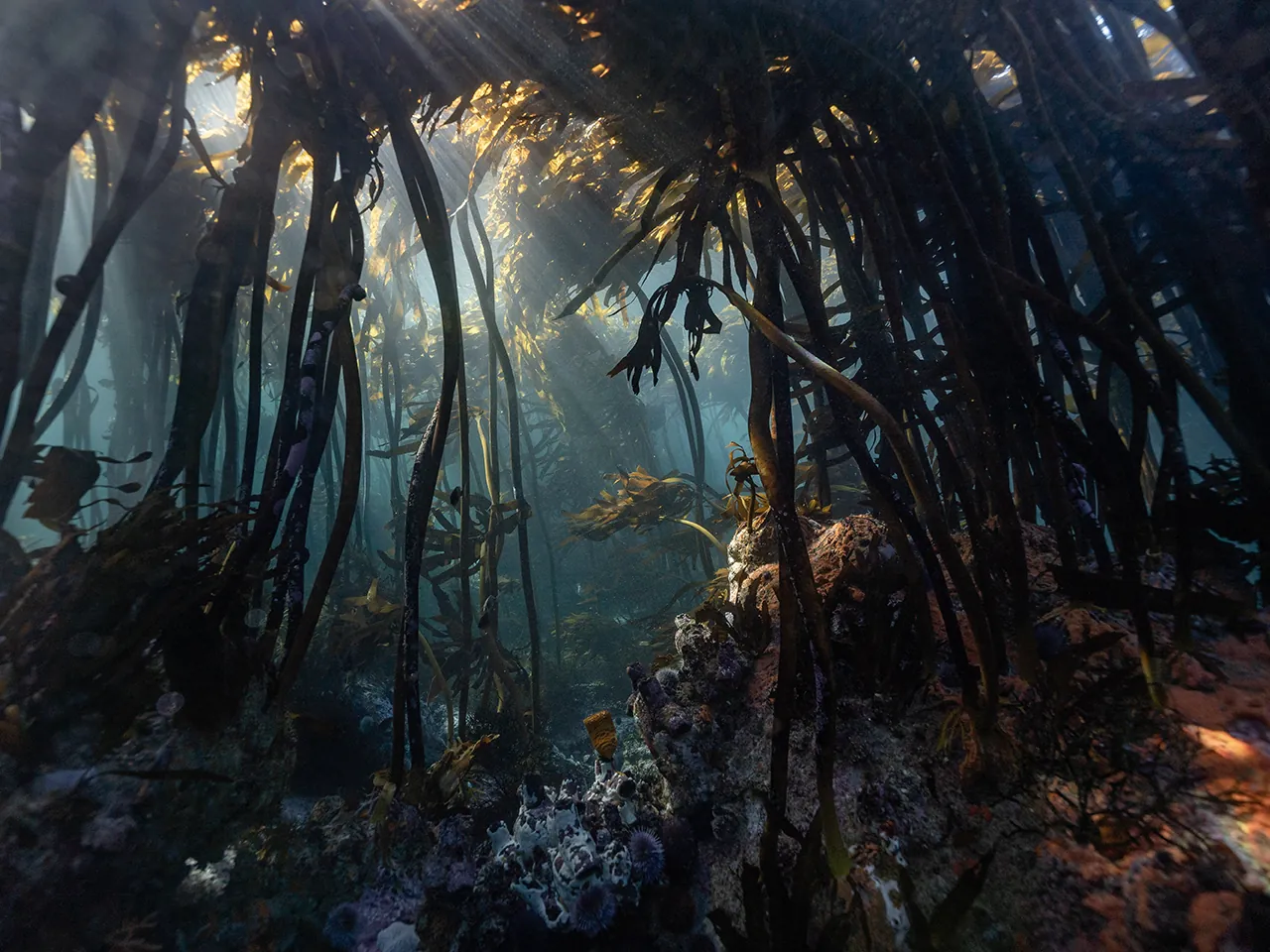


Cape Point near False Bay marks a biological break point for marine species distributions and is home to the Great African Seaforest, a unique and diverse kelp forest ecosystem. Our team has explored and cherished this region for over a decade, helping it gain recognition as a valuable marine ecosystem. We carefully embedded the name ‘Great African Seaforest’ in all our media work, and in 2021 it was named a New World Wonder. This iconic status will help towards its long-term protection.






Aims
As environmental challenges threaten the last remaining wilderness areas of our planet, we use underwater tracking, marine biology research, and storytelling to:
- Foster a holistic understanding of the marine environment
- Connect people to nature, inspiring an emotional bond and care for the natural world
- Raise awareness locally and globally about biodiversity’s essential role in human survival, promoting active participation in protecting the web of life
- Highlight the significance of the Great African Seaforest to safeguard its iconic status and support its preservation
- Bridge gaps between the science-to-policy interface to inspire political action
- Encourage world business leaders to adopt a nature-centred value system
OUR THREE-PRONGED APPROACH
Underwater Tracking
An observational skill honed through presence and connection with the environment, tracking enables a deeper understanding of the seaforest, sometimes even the discovery of new species or novel animal behaviours.
Research
Storytelling
Beacon of Biodiversity
The Great African Seaforest and the ocean at our doorstep represent not just hope, but a living system that enriches our planet at a time when global awareness, policy and enforcement are urgently needed to restore the health of our natural world.
Our 1001 Seaforest Species project is centred around this remarkable kelp forest and the vital marine biodiversity it supports. Through documenting and highlighting the unique characteristics of the species within the Great African Seaforest ecosystem, we emphasise their interdependence and their crucial role in the health of the world’s oceans.
Our strategic objective is to accelerate global awareness of kelp forests in key domains, including the general public, the scientific and conservation communities, governments, multilateral institutions and businesses. We aim to inspire people worldwide to create conditions where such ecosystems can flourish and to energise individuals to take personal action in protecting biodiversity, leading to a deeper sense of purpose and meaning in their lives.

Rock Crab
Rock crabs are key players in the subtidal ecology of South African kelp forest shores, forming healthy populations of omnivorous foragers. While they hunt for small invertebrates, they must stay alert, as they are amongst the favourite food of the octopus. Rock crabs have an impressive escape mechanism: their flattened legs are perfectly adapted for quick swimming when needed.
App
We’re excited to launch the 1001 Seaforest Species app in 2025—a free, custom-built guide to the incredible marine life found in the Great African Seaforest. Designed with an intuitive species identification tool, the app will help users explore a range of categories, from fish to crustaceans and mollusks, and identify individual species with ease. This resource is tailored for the local marine community and anyone fascinated by ocean biodiversity. Highlighting rare and unique species found only in our region, the app will also contribute valuable knowledge to global biodiversity by including new discoveries and first-ever live images of marine life.
Social
#0015 Cape sole – Heteromycteris capensis
Like all soles and their related flounders, these endemic fish are easily recognised by their extremely flattened bodies. For casual observers, however, seeing a Cape sole – let alone recognising it – can be tricky, as they are often partially buried in sediment, lying on their left sides, and are typically cryptically patterned. They can also be confused with other regional species – of which there are about 50 – as their colour patterns are highly variable and can quickly change in the same individual to match the background. So, what identification features set the Cape sole apart? First, they lack the upper pectoral fin (the small fin situated just behind the fish’s head), and, second, they have a distinctively hooked snout that curves over their mouth. However, getting close enough to observe these can be challenging, as Cape soles swim away on their sides and rebury themselves when disturbed. But in a fascinating interaction, Craig got up close and personal with one individual that decided to cling to his hand. Can you guess why? Read his blog on our website to find the answer (link in bio).
#1001species #1001seaforestspecies #saveourseasfoundation #seachangeproject #marinebiology #greatafricanseaforest #taxonomy #capesole @saveourseasfoundation

#14 Upside-down ascidian amphipod – Policheria atolli
These delicate, 5mm-long shrimp-like animals are expert excavators. They create shallow burrows in the surface of ascidians – which are sessile organisms that grow on rocks – and then lie upside-down inside them with their legs pointing upwards. To protect themselves from predators, these little creatures have nippers on the end of their legs, which can be used to pull their burrows closed – a bit like drawing a curtain. Other specialised legs pump water through the burrow and capture food. Our marine biologist and scientific lead of the 1001 Seaforest Species project, Jannes Landschoff, recently stumbled upon a colony of these amphipods in an unusual place. See his blog for more – link in bio.
#1001species #1001seaforestspecies @saveourseasfoundation #taxonomy #greatafricanseaforest #seachangeproject #storytelling #marinescience

#0013 Colonial worm-shell (Dendropoma corallinaceum)
They might look like worms, but these ‘reefs’ of whorled creatures are actually snails. What’s unusual about these gastropods is that they don’t move, hence the possible confusion with worms. Permanently attached to surfaces, often rocks, they form dense colonies that are normally overgrown by coralline algae. Here, they catch food by making a net out of mucus, which they cast out to snag floating particles and then haul in to devour their meal whole. These encrusting snails benefit from being sessile by being able to stand their ground in a high-wave environment in the lower intertidal zone. However, this sedentary lifestyle means they are easy pickings for predators such as rock crabs.
Pictures: Jannes Landschoff
@saveourseasfoundation #1001seaforestspecies #biodiversity #taxonomy #seachangeproject #marinescience #1001species

#0012 Sinous sea fan — Eunicella tricoronata
Look at the first shot and you’ll see what looks like a fuzzy halo around the branches of this sinous sea fan. Zoom in on the second macro image, and you’ll see what this is: hundreds of pale polyps topped by eight tentacles that create a star-like formation. These tiny appendages are the engines that keep the colony alive. Sinous sea fans, found in a range of yellow and orange hues, have a stiff inner skeleton made of a horn-like protein called gorgonin. They’re slow-growing and are thought to live for decades – thanks to those little tentacles. When the polyps are extended, creating that ‘fuzz’, the eight tentacles snag small planktonic organisms from the water column. Sinous sea fans are popular sites for catshark eggs, as they have stinging cells that protect the egg casings from whelk predation (see image 3).
@saveourseasfoundation #1001 #1001seaforestspecies #greatafricanseaforest #marinescience #taxonomy #biodiversity #seachangeproject #1001species

#0011 – Feather star shrimp – Hippolyte catagrapha
Safety definitely comes first for this cunningly camouflaged shrimp. Can you spot it hidden along the arms of this Elegant feather star? Its colour not only matches its host, it also has a longitudinal stripe that blends in with the arms of the feather star. Because of their incredible camouflage and cryptic behaviour, Feather star shrimps are not easy to spot. However, usually one shrimp can be found on every large Elegant feather star. Even though these two species live closely together there’s still a lot we don’t know about the shrimp’s life - like what it eats. We think that the shrimp snatches food particles from the Feather star’s arms, though much remains to be discovered about this fascinating relationship.
Pictures: Jannes Landschoff
@saveourseasfoundation #1001species #1001speciesproject #biodiversity #greatafricanseaforest #seachangeproject #1001species

0010 – Limpet amphipod (Calliopiella michaeleni)
This shrimp-like amphipod, with its funky green body and red eyes, has found the perfect house-sharing set-up. It lives in the mantle cavities on the underside of limpets such as goat’s eye and pink-rayed limpets, where it is protected and feeds on the limpets’ faeces and possibly on algal fragments. Usually occurs in male and female pairs, territorially defending their host against other amphipod individuals, these co-habitors pay their way by keeping the place clean.
Pictures: Charles Griffiths
#1001seaforestspecies #saveourseasfoundation #marinebiology #taxonomy #greatafricanseaforest #seachangeproject #1001species

#0009 Mantled keyhole-limpet (Pupillaea aperta)
These large gastropods are endemic to Southern Africa and resemble sci-fi-worthy cloaked beings. They are covered by a firm, fleshy mantle that ranges in a myriad colour combinations, from yellow, orange and blue with dots, to brown, black, mottled and striped. These animals are large, but due to their camouflage are not always easy to spot. We are always amazed to see how animals blend into the kelp forest habitat. At first glance, keyhole limpets can look like shell-less sea slugs, however this species has a highly reduced internal shell and often appears ‘naked’, but has a small shell with a ‘keyhole-shaped’ opening at the top, hence the name. Mantled keyhole limpets are usually loners fond of eating sponges – the individual in the picture is seen competing with an orange starfish for its lunch. There’s still so much to learn about these curious-looking creatures.
Pictures: Jannes Landschoff and Craig Foster
@saveourseasfoundation #1001seaforestspecies #mantledkeyholelimpet #greatafricanseaforest #taxonomy #biodiversity #1001species

#0008 – GHOST DORID - Leciphorus capensis
Ghost dorids are small nudibranchs (sea slugs) often found on densely colonised rocky reefs. Like all nudibranchs they bear naked rosette-shaped gills on their back, hence the name (‘naked gills’). These aptly named animals are almost see-through and if you look at the close-up image, you can see a dark shape, called a visceral mass, that contains the dorid’s organs. One of these is its digestive system, which gladly receives snacks such as encrusting bryozoans. On one of our dives we were excited to photograph an animal snacking - can you try and spot how the nudibranch in the second image contracts its head in order to scrape into the bryozoan? What these images don’t show is just how small Ghost dorids are, and it takes a keen eye to find them in the vast Great African Seaforest.
Pictures: Jannes Landschoff
#1001seaforestspecies #nudibranchs #ghostdorid #greatafricanseaforest #seachangeproject @saveourseasfoundation #marinebiology #natureconnection #1001species

#0007 Cape urchin (Parechinus angulosus)
These prickly characters – usually in purple, red or orange hues – are a common sight in the shallow waters of the Great African Seaforest. While in other parts of the world, urchins are often associated with kelp ‘deforestation’, Cape urchins play important roles in their community, including keeping kelp density in check through grazing, and protecting juvenile abalone that shelter under their spines. They’re also innovative, covering themselves with empty shells, algae or any suitable objects to serve as sunhats. Spotting a row of them wearing these always brings a smile.
Pictures: Jannes Landschoff
#1001 #capeurchin #marinescience #greatafricanseaforest #kelpforest #saveourseasfoundation #seachangeproject @saveourseasfoundation #1001species #1001seaforestspecies

#0006 – KELPSUCKER - 𝘌𝘤𝘬𝘭𝘰𝘯𝘪𝘢𝘪𝘤𝘩𝘵𝘩𝘺𝘴 𝘴𝘤𝘺𝘭𝘭𝘪𝘰𝘳𝘩𝘪𝘯𝘪𝘤𝘦𝘱𝘴
Dozens of little eyes peer out of their eggs like silver cake decorations. They belong to a fresh batch of kelp sucker fish, a clingfish that has slick sticky skills. These petite fish use a disc-like sucker formed from modified pelvic fins to adhere themselves to surfaces. The goggle-eyed eggs will hatch within two to three weeks after being laid in the kelp fronds and the larvae will eventually grow to a maximum length of about 3.5cm (they’re small little suckers!). Once out in the world, they will feast on small crustaceans and use the kelp as a hiding place from predators.
#1001species #1001seaforestspecies #seachangeproject #greatafricanseaforest #capetown #kelpsucker #capetownsouthafrica #freedive #ocean #fishofinstagram
Pictures: Craig Foster and @jannes_landschoff

#0005 – KELP LIMPET (Cymbula compressa)
Seaforest species have intricate, interlocking lives, essential for survival.Among them, the Kelp limpet’s elongated-boat shaped shell stands out as an excellent example of adaptation. The unique form enables them to fit snugly against the narrow, curved stipes of Bamboo kelp, anchoring themselves securely on a swaying home in a shifting sea.
But life doesn’t begin that way: after a larval stage in the open water, juveniles settle on the broad, flat fronds of the kelp and initially grow flat shells to match the terrain. Once they reach the size of a postage stamp, they migrate to the kelp stipe where they gradually transform their shells into the iconic boat-like shape.
This is probably a bonus for the kelp too. By grazing on the stipes, limpets prevent epiphytic algae from taking hold, reducing drag and lowering the risk of the kelp being uprooted during fierce storms.
#1001species #1001seaforestspecies #seachangeproject #greatafricanseaforest #capetown #kelplimpet #capetownsouthafrica #freedive #ocean

#0004 – SEAFOREST KLIPFISH (𝐶𝑙𝑖𝑛𝑢𝑠 𝑎𝑟𝑏𝑜𝑟𝑒𝑠𝑐𝑒𝑛𝑠)
It took many days for this large male Seaforest klipfish to reveal the secrets of his hidden world. Initially cautious, he would swim away and keep its distance. Yet, dive after dive, Jannes patiently returned to the same spot, gradually earning the fish’s trust. Eventually, he could draw close enough to follow the klipfish to its favourite hiding place beneath a canopy of red algae and watch it hunting crustaceans among the rocks. He found himself gazing into the fish’s glittering round eye. What would this magnificent kelp forest world look like through such marvellous reflective eyes?
#1001species #1001seaforestspecies #seachangeproject #greatafricanseaforest #capetown #seaforestklipfish #capetownsouthafrica #freedive #ocean #saveourseasfoundation

TEAM
1001 Seaforest Species is a multifaceted project with ambitious goals, made possible through the hard work, support, and collaboration of many valued contributors

Dr Jannes Landschoff
Jannes is a marine biologist, trained crustacean specialist and ecologist who leads the scientific research for 1001. His interests and talents in the field of natural history span from documentary photography and film to ecological biodiversity research and conservation. He is a Research Fellow at the Department of Botany and Zoology, Stellenbosch University.

Craig Foster
Craig has spent more than a decade practising underwater tracking in the Great African Seaforest. He brings these skills to the project by closely observing the ways of the 1001 species, learning from them, and then using his storytelling background to weave rich tales about their often secret lives.

Emer Prof. Charles Griffiths
Emeritus Prof Charles Griffiths is a former Head of the Zoology Department and Director of the Marine Biology Research Institute at University of Cape Town. He has been studying the marine fauna of the region for over 50 years and has described over 100 species new to science. He is author of several guide books to regional fauna and produces a YouTube channel, Explore the Shore ,with his son Matthew. He wrote many of the 1001 Seaforest Species pages.
TRACKING ACKNOWLEDGEMENTS
Craig would like to acknowledge his original tracking mentors — !Nqate Xqamxebe, Karoha Langwane, and Xlhoase Xlhokhne — who inspired his journey into underwater tracking. This technique, shared with Jannes and the Sea Change team, continues to evolve, has led to numerous scientific discoveries and strongly influences the project, for which we are deeply grateful. We also extend our thanks to master tracker JJ Minye for his invaluable contributions to our intertidal and coastal tracking practices.
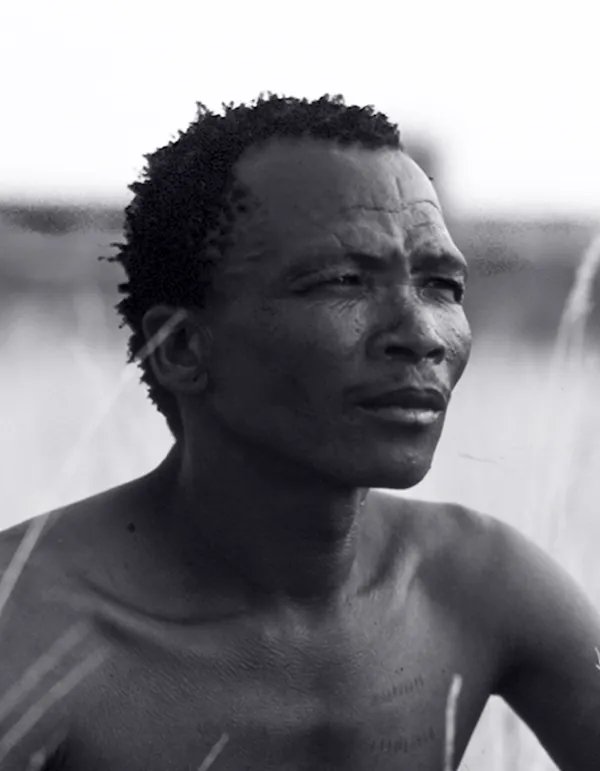
!Nqate Xgamxebe

Karoha Langwane

Xlhoase Xlhokhne

JJ Minye
Principal Partners
Over the years we’ve had the privilege to come to know and work with many of the deeply passionate team from the Save our Seas Foundation (SOSF) – our 1001 Seaforest Species principal collaborator and funder. SOSF have spent over 20 years protecting sharks and rays around the world. We feel very grateful to work with this fabulous team of scientists and storytellers, together giving voice to the countless voiceless animals that are our teachers, our inspiration and our life support system.
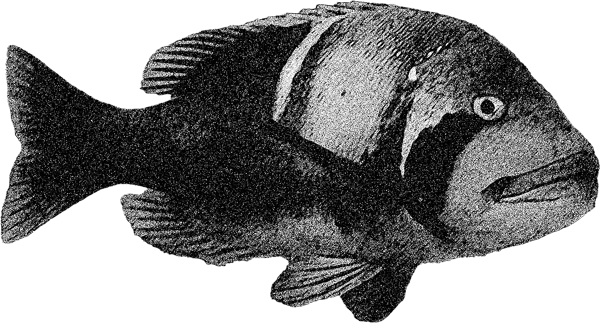
Red Roman
The Red roman is one of the kelp forest’s most iconic fish, known for its curiosity towards divers. These fish start life as females in small groups but, at around 30 cm, transform into males and become territorial over a specific area. In protected environments, they can live for at least 17 years, becoming like kin to those of us who dive there regularly. This large male Red Roman followed us closely on one of our swims, adding to the feeling of being at home in the seaforest.
Media
Recent Articles
New discoveries: three tiny species added to South Africa’s spectacular marine life

